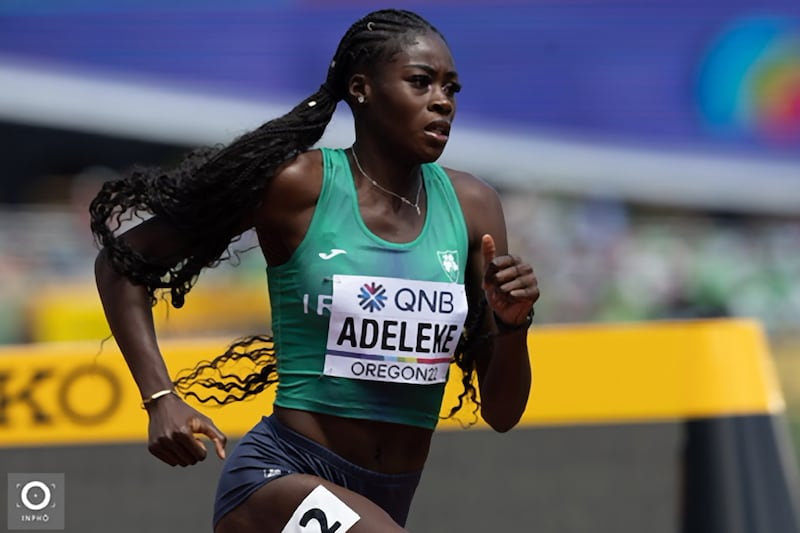TODAY is International Women’s Day, which has been observed as a special day for women everywhere for more than a century.
Streets, markets, offices, and other public places in many countries are adorned in pink and purple to mark the occasion. It is also the ideal opportunity to celebrate the Irish female athletes who have excelled on the international stage.
You only need to go back a few days to the World Indoor Championships in Glasgow to see how Irish female athletes consistently bring honour to the country.
Sarah Lavin and the women’s 4x400m relay team of Phil Healy, Sophie Becker, Roisin Harrison, and Sharlene Mawdsley both achieved top-five finishes, while Mawdsley was unfortunate not to make the final of the individual 400m after suffering a harsh disqualification.
Other women to impress were Roisin Flanagan and Sarah Healy, who also showed they could compete with the best in the world in their respective events.
However, the contribution of Irish women goes back much further, in fact over a century, to a woman who was not only a pioneer in athletics but also in aviation.
Lady Mary Heath, as she is best known, was born Sophie Peirce-Evans in Knobkerry, Co Limerick, on November 17 1896. She was introduced to sport at the boarding schools in Cork, Belfast and Dublin, playing hockey and tennis.
She continued playing hockey after she enrolled at the Royal College of Science for Ireland and, tall at 1.82m, became a mainstay of her team’s defence.
Following an early marriage in late 1916, the new Mrs Eliott-Lynn signed up as a motor dispatch rider with the War Office, only returning to Dublin in mid-1919 when the First World War was over.
With her husband granted a farm in Africa, she stayed on in Dublin, resuming her studies and continuing her involvement in sport, attempting among other things to set up a ladies’ cricket team.
At the time, women’s athletics was something of a novelty, as indeed were women’s sports generally. In May 1921, with women’s athletics not included in the Olympic programme, the French woman Alice Milliat organised the first Olympiades Feminines held in the glamorous surroundings of Monte Carlo.
Eliott-Lynn’s Dublin debut came at the Dublin Tramway Sports in Lansdowne Road, where she won the high jump with a modest height of 4ft (1.219m). A considerably better jump of 4ft 6ins (1.371m) at the Clonliffe Harriers Sports in Lansdowne Road was enough to rank her second in Britain and Ireland in 1921.
The following year, and now based in London, she was elected vice-president of the newly-formed British Women’s Amateur Athletic Association in England.
The highlight of the season was the first Women’s Modern Olympic Games in Paris, organised to coincide with the second FSFI conference in August and attracting 20,000 spectators.
In the two-handed shot, Eliott-Lynn finished ninth. Back in London she helped Kensington Ladies win the first ever women’s inter-club match held at the Croydon Sports Club.
She joined her husband in Africa that autumn and trained every day. At the third Olympiades Feminines in Monte Carlo in early April 1923, she finished third in both the high jump and javelin. These were her first international medals.
After another winter in east Africa, she returned to England in early 1924, joining the newly formed Middlesex Ladies Athletic Club. Her finest moment as an athlete came at the second annual English Women’s Championships in the Woolwich Stadium, London, on June 28 1924.
In the two-handed javelin, she added over 17 metres to her throw of a year earlier with a magnificent aggregate total of 52.78m which obliterated and world record, although a slight wind meant her performance was never officially ratified. She also won the high jump.
In early June, she competed in the first Daily Mirror Trophy at Stamford Bridge, and a month later, at the WAAA Championships at the same venue where she finished third in the high jump and second in the javelin.
After her well-publicised first flight at the opening of the London Aero Club at Stag Lane on August 19, she decided to take flying lessons. Over the next year, she would juggle her two interests, practising her javelin at Stag Lane when she could not fly.
On October 18 1925 she flew solo for the first time, later describing it as “the most thrilling adventure of my life”. A year later, just shy of her 29th birthday, she became the first woman in Britain to be awarded a commercial pilot’s licence. Her final appearance as an athlete came in May 1927 when she competed in a pentathlon in London.
In 1928, now remarried and known as Mary Lady Heath, she became the first person, man or woman, to fly a small plane single-handed from Cape Town to London.
She travelled to the United States in late 1928 and an air crash in August the next year effectively ended her career.
She would die, alone and unknown, in London on May 9 1939, aged just 42, following a fall in a double-decker tram car.
However, she had blazed a trail in women’s athletics that many other Irish athletes would follow. These include, among others, Maeve Kyle, Thelma Hopkins, Mary Peters, Sonia O’Sullivan, and Catherina McKiernan – all stars on the international stage and bringing honour to the island.





